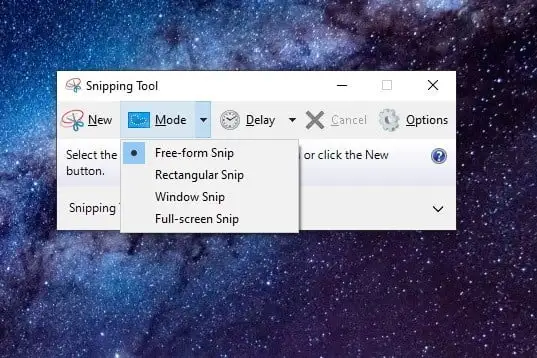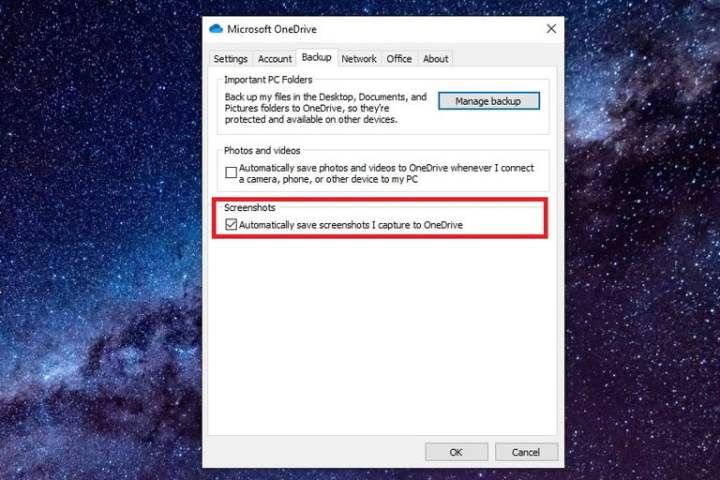
Mark Coppock/Digital Trends
Screenshots are incredibly helpful for capturing images on your desktop, but the method for taking one on a Windows laptop or PC may not be immediately obvious if you haven’t done it before.
There are a number of ways to accomplish this simple task in Windows, and we’ve detailed each of the available methods below. And yes, most of these methods work just as well in Windows 11 as in Windows 10. Read on to learn how to take a screenshot on a Windows PC.

Image used with permission by copyright holder
Snipping tool in Windows 10 and 11
The best native method for taking a screenshot in Windows is via the Snipping Tool. This built-in screen-capture utility works well enough, but it’s not the most robust or versatile when it comes to saving a snapshot. However, it is a utility that allows users to better define and capture portions of their desktop display as a screenshot. Here’s how to use it.
Step 1: To start, just type snipping tool into the taskbar’s search box and select the resulting app. If you’re on Windows 10, once it opens, you’ll see a notification that it’s “moving to a new home” in a later update. Don’t worry. Even in Windows 11, it’s still an available tool, but Microsoft encourages you to use the Win + Shift + S keyboard shortcut.
Step 2: On Windows 10, select the Mode button to expand its menu. You’ll find four screen-capturing options: Draw a window (Free-form snip), box in an area (Rectangular snip), capture the current window (Window snip), and capture the entire screen (Full-screen snip).
On Windows 11, you’ll need to either select New or press the Windows key + Shift + S keyboard shortcut in order to start a snip. Once you’ve done either, the screen will darken a bit and you’ll be presented with the four aforementioned “mode” options at the top of your screen.
Select one of these modes to start your screenshot.
Step 3: Once you capture a screenshot, the Snipping Tool interface will display your screenshot. You can perform light edits like using a pen or highlighter, or erasing something.
(In Windows 11, this editing screen may show up automatically, or you’ll have to select a notification that pops up first in order to open the editing screen.)
Step 4: When you’re done editing within the Snipping Tool, select File in the upper-left corner and then click the Save as option listed on the drop-down menu.
In Windows 11: Select the Save as disk icon in the top-right corner, name your file on the screen that pops up, and select the Save button.

Image used with permission by copyright holder
Snip & Sketch tool in Windows 10
Snip & Sketch is Microsoft’s newer version of its snipping utility, and it’s a great way to take a screenshot on your Windows PC. You can access this tool from the Start menu or by typing Win + Shift + S on your keyboard. Here’s how to use it.
(Note: Snip & Sketch is no longer available on Windows 11 and has been replaced by a updated Snipping Tool app that incorporates elements of Snip & Sketch. That said, the following instructions (particularly steps 1, 2 and 4) should still be generally correct for Windows 11’s Snipping Tool).
Step 1: If you use the keyboard shortcut, the screen darkens and renders a five-button toolbar along the top. You have the same functions found in the older Snipping Tool, but it doesn’t save your screenshots as a file. Instead, the image goes straight to your clipboard first.
Step 2: You’ll also see a desktop notification that informs you that the image has been copied to the clipboard. This same notification gives you the option to edit the captured image within the Snip & Sketch app. You can access this latter option by selecting the desktop notification itself. If you select the notification, the screenshot loads within the app, allowing you to crop the image and apply a pen, pencil, highlighter, or eraser.
Step 3: If you load the Snip & Sketch app instead, select the drop-down arrow next to the New button in the top-left corner and select Snip now in the drop-down menu. The screen darkens, and the five-button toolbar appears. Take your snip, and your desired image should automatically load in the Snip & Sketch app, ready for you to edit.
Step 4: Save the image anywhere on your PC by choosing the Disk-style button. If you want to edit and save the screenshot using any installed image editor, select the Three-dot icon on the toolbar and choose the Open with option on the drop-down menu. (In Windows 11, you’ll just select the Edit in Paint button, to edit the screenshot in Microsoft Paint.)
Print screen keyboard shortcuts
Windows provides six methods to take a screenshot of your desktop as an image using keyboard shortcuts. Three are based on the Print Screen (PrtScn) key, while the remaining three require the Windows (Win) key.
On external keyboards, you’ll find a dedicated PrtScn key located in the upper-right corner. The Win key typically resides on the lower-left, between the Control (Ctrl) and Alternate (Alt) keys. It sports the Windows logo, so it’s hard to miss.
On laptops, the Print Screen command may be combined with another function on a single key. In this case, you must press the Function (Fn) key in addition to the Print Screen key.
Here’s a breakdown of the six screen-capture commands:
-
Print Screen (PrtScn): Captures the entire screen. If you have more than one display, this function captures everything shown across all connected displays as a single image. By default, this method does not save your image as a file, but merely sends the captured image to the Windows clipboard. (On Windows 11, pressing the Print Screen button on your keyboard may automatically open the Snipping Tool instead. But you can disable this by going to Settings > Accessibility > Keyboard, then toggling off the Use the Print screen key to open Snipping Tool.)
-
Alt + Print Screen: Captures a single window. Be sure to highlight the target window first, such as a document or browser, before pressing these two keys (or three on certain laptops). By default, this method does not save your image as a file, but just sends the image contained in the capture window to the clipboard.
-
Win + Print Screen: Captures the entire screen. The difference here is that Windows saves the image as a file. By default, it’s sent to C:Users
Pictures>Screenshots or C:Users OneDrive>Pictures>Screenshots on your PC. -
Win + Shift + S: Captures a screenshot using the built-in screenshot tool called Snip & Sketch (or the new Snipping Tool app in Windows 11). The screen dims and provides four choices on a small toolbar (not including the Exit icon): Rectangular snip/mode, Freeform snip/mode, Window snip/mode, and Fullscreen snip/mode. This tool does not save captures as an image, but merely sends them to the clipboard.
-
Win + G: Opens the Xbox Game Bar. Select the Capture button and then the Camera icon, and this tool will save an image to C:Users>(user name)>Videos>Captures by default.
-
Win + Alt + Print Screen: Captures only the active window. This command saves an image to C:Users>(user name)>Videos>Captures by default.
In some cases, the screen flickers or dims to signify that Windows has grabbed a screenshot. If this doesn’t happen, open File Explorer and head to their respective default locations to see if Windows saved your image.

Image used with permission by copyright holder
OneDrive in Windows 10 and 11
If you’re using OneDrive, you can save screenshots on your Windows PC to the cloud so they’re accessible from every device. It does not save screenshots by default, however. Instead, you must select the Cloud icon next to the System clock (or in the Hidden icons menu marked with an upward-facing arrow).
If this icon isn’t appearing, you may need to open the OneDrive app first and sign in to your account. After selecting the Cloud icon, choose the Help & settings gear icon and select Settings on the pop-up menu. Next, choose the Backup tab in the resulting pop-up window and check the box under Screenshots. Then select OK.
(In Windows 11, after selecting Settings, choose the Sync and backup tab on the left-hand side. On the Sync and backup screen, turn on the Save screenshots I capture to OneDrive option.)
In this case, you can press the first two Print Screen commands to automatically save an image file to OneDrive. You won’t see the screen flicker or dim for these commands — you’ll receive a notification instead. Be sure to sync the Screenshots folder if you want to access the images on your PC.
How to take a screenshot on other devices
If you’re trying to learn how to take a screenshot on a Mac instead of a Windows PC, taking a screenshot is super simple as well. There are a number of methods to get it done, but the easiest involves using some handy keyboard shortcuts. Command + Shift + 3 will capture the whole screen, while Command + Shift + 4 will let you draw out a selection box.
You can also easily take a screenshot on a Microsoft Surface.
In order to take a screenshot on a Chromebook, again, there are a few different methods, but the easiest is a keyboard shortcut. Control + Show Windows keys will capture the whole screen, while Control + Shift + Show Windows will let you capture a selected area.
